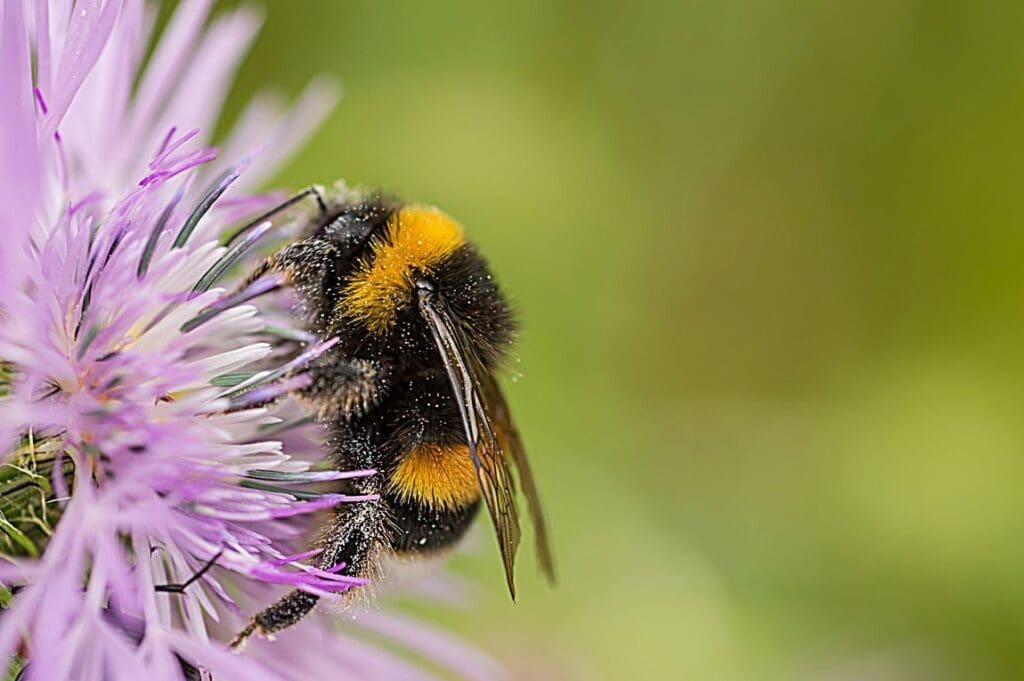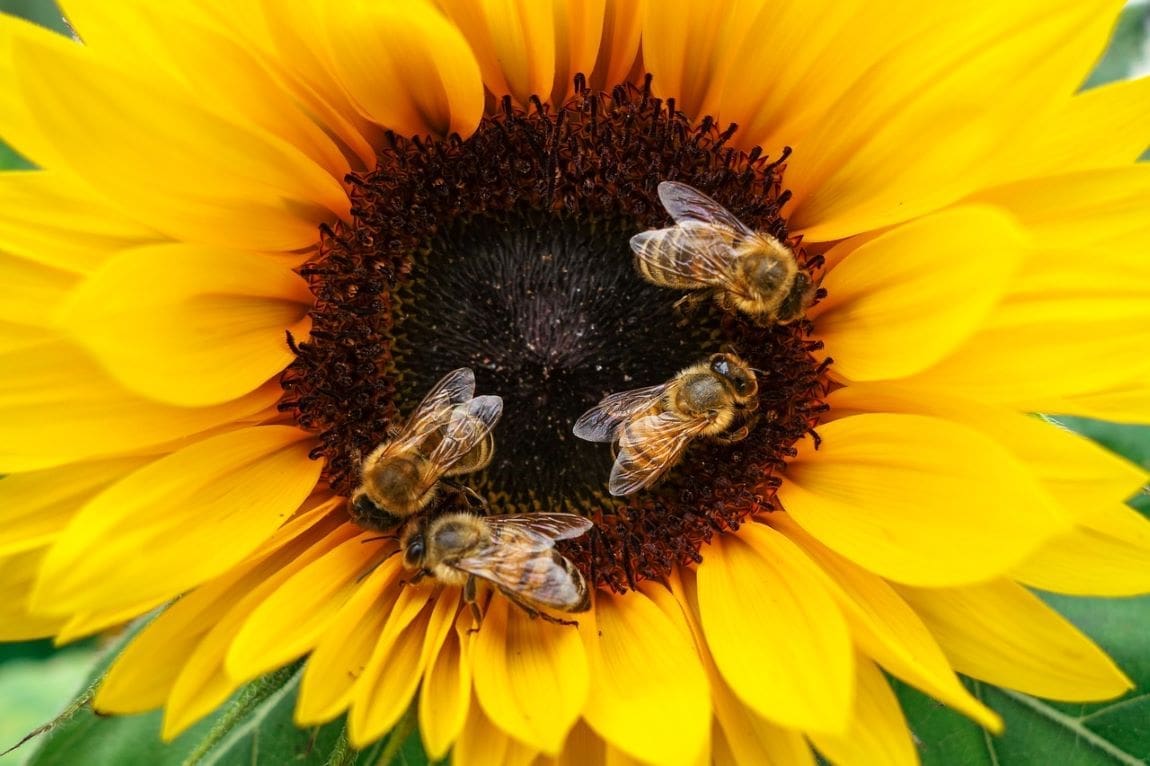The preferences of bees for specific floral traits play a crucial role in pollination, shaping ecosystems and food production.
A recent study led by researchers at Penn State, published in PNAS Nexus, reveals how different bee species prioritize either the abundance or nutritional quality of flowers while foraging. This nuanced understanding could guide habitat restoration efforts to support declining pollinator populations and ensure sustainable ecosystems.

Penn State – When it comes to deciding where they’re going to get their next meal, different species of bees may be attracted to different flower traits, according to a study led by researchers at Penn State.
The study focused on two species of solitary bees: the horned-face bee, which helps pollinate crops like apples and blueberries, and the alfalfa leafcutting bee, which pollinates alfalfa.
The researchers found that the horned-face bees tended to prefer plants with a large number of flowers — for them, quantity was most important. Meanwhile, the alfalfa leafcutting bees tended to visit flowers with a high pollen protein-to-lipid, or more protein than fat, content ratio. In this case, they prioritized nutritional quality.
Jaya Sravanthi Mokkapati, first author on the study and a postdoctoral scholar in the Penn State College of Agricultural Sciences and Center for Pollinator Research, said that understanding how different bee species forage can help guide conservation efforts.
“Information on the foraging strategies of different bee species give insights for understanding how plant–pollinator interactions evolved,” Mokkapati said. “Our study also highlights the need for more research on seasonal foraging habits among various bee species, which can deepen our understanding of their vital role in pollination and plant reproduction.”
Pollinators and flowering plants have evolved side by side over thousands of years to develop a mutually beneficial relationship, the researchers said. As bees visit flowers to collect nectar and pollen for food, they help plants reproduce by spreading their pollen. Since many crops require pollination to produce their fruits, vegetables or nuts, the process underpins food security for humans.
Unfortunately, many pollinator populations are in decline, the researchers added, and a major contributor to these declines is the loss of flowering plants.
Understanding which floral traits are especially attractive to bees can help in restoring pollinator habitats, according to co-author Christina Grozinger, Publius Vergilius Maro Professor of Entomology and director of the Penn State Center for Pollinator Research.
“Bees can be attracted to plants based on a number of traits, such as the color, scent, size, number and nutritional content of its flowers,” she said. “However, because these traits are co-evolved in flowers, it can also be very challenging to pinpoint which traits are the ones attracting which bees.”
For the study, the researchers worked with their collaborators in the Swedish University of Agricultural Sciences, who crossed the self-fertilizing Capsella rubella plant and the pollinator-dependent outcrosser C. grandiflora to produce 20 different genetic lines of plants that varied across floral traits. These traits include floral resource quantity — assessed through the number and size of flowers — and floral nutritional quality, which was evaluated based on pollen protein concentration, lipid concentration and the protein-to-lipid ratios.
This resulted in different floral traits being uncoupled from each other, which allowed the researchers to test which trait, specifically, was most attractive to different bee species.
The differences in foraging behavior between the two species of bees may be due to resource availability, the researchers said. For example, the horned-face bee is a spring species that faces limited food sources that are only available for a short time. Because of this, they may forage for whatever is available and prioritize the quantity of flowers.
“In contrast, the alfalfa leafcutting bee is a summer species that typically has access to more abundant resources,” Mokkapati said. “We hypothesized that these bees can afford to be more selective, choosing flowers based on nutritional quality instead of quantity.”
The findings could be helpful for restoring pollinator habitats, the researchers said. For example, landscape managers could plant a variety of flowers that cater to the bees’ specific needs, which is essential for supporting their populations. They could also create habitats that ensure food sources are available that are attractive and nutrition for bees throughout the growing season, promoting healthy ecosystems.
Additionally, Mokkapati said educating the public and stakeholders about the specific needs of these bee species can encourage support for initiatives like native plant gardens and other efforts that create pollinator-friendly environments.
“By raising awareness of how these gardens can provide essential resources for bees, we can inspire community involvement and commitment to preserving local biodiversity,” she said. “This collective effort not only benefits the bees but also enhances the beauty and ecological health of our surroundings.”
The researchers said in the future, additional studies could explore why these species differ in their foraging strategies, especially in terms of their sensory and cognitive processes and why these different strategies evolved.
Michael Hill, former graduate student at Penn State; Natalie Boyle, assistant research professor of entomology at Penn State; Pierre Ouvrard, Swedish University of Agricultural Sciences; and Adrien Sicard, Swedish University of Agricultural Sciences, also co-authored this study.
***
This research was support by a grant from the Human Frontier Science Program to Grozinger, Sicard and Benjamin Risse, a collaborator at the University of Münster in Germany. Additional support was provided by the Penn State Huck Institutes of the Life Sciences and the United States Department of Agriculture’s National Institute of Food and Agriculture.
Journal Reference:
Jaya Sravanthi Mokkapati, Michael Hill, Natalie K Boyle, Pierre Ouvrard, Adrien Sicard, Christina M Grozinger, ‘Foraging bee species differentially prioritize quantity and quality of floral rewards’, PNAS Nexus 3 (10) pgae443 (2024). DOI: 10.1093/pnasnexus/pgae443
Article Source:
Press Release/Material by Penn State
Featured image credit: Thomas | Pixabay




